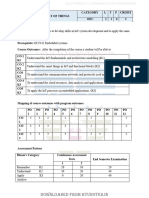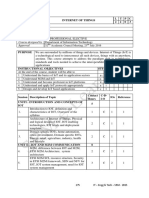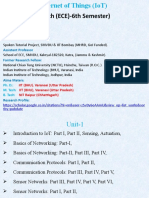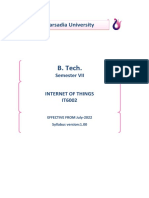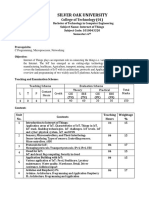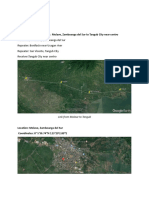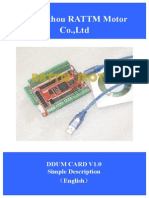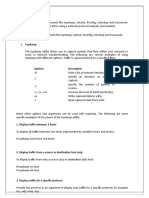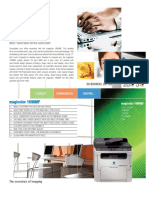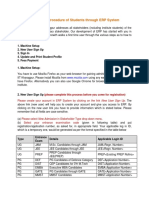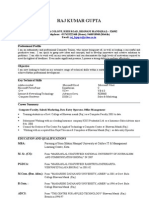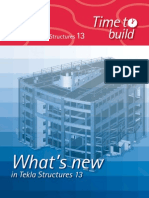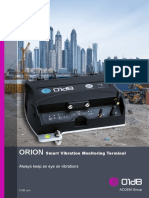CHO 25ECE0211 IoT B2024 Sem3
Uploaded by
suhanagoyal01CHO 25ECE0211 IoT B2024 Sem3
Uploaded by
suhanagoyal01Course Plan
Course Handout
Institute/School Name Chitkara University Institute of Engineering & Technology
Department Name Department of Computer Science & Engineering
Program Name Bachelor of Engineering- Computer Science & Engineering
(Artificial Intelligence and Machine Learning)
Course Name Programming the Internet of Things Session 2025-2026
Course Code 25ECE0211 Semester/Batch 3rd /2024
L-T-P (Per Week) 1-0-2 Course Credits 2
Pre-requisite Fundamentals of programming and NHEQF Level 5
logic building
Course Coordinator Dr. Anshu Sharma SDG Number 4, 9
1. Objectives of the Course
The main objectives of the course are:
• To Provide a comprehensive understanding of IoT fundamentals, architecture and key components
(sensors, actuators, protocols).
• To equip students with skills to design and implement IoT systems using logical/physical design
methodologies and enabling technologies.
• To foster critical analysis of IoT vs. M2M, SDN and NFV in modern networked environments.
• To enable hands-on experience in developing IoT applications using cloud platforms and layered network
protocols (Link, Transport, Application layers).
2. Course Learning Outcomes (CLOs)
After completion of this course, the student shall be able to:
Program NHEQF
Level No. of
CLO Course Outcome Outcomes Lectures
(PO) Descriptor
CLO01 Demonstrate understanding of IoT fundamentals, PO1, PO2 Q1
encompassing system architectures, core
8
components (sensors and actuators) and principles of
resource management in IoT ecosystems.
CLO02 Formulate and design IoT system solutions through PO1, PO2, Q2, Q4
systematic application of physical and logical design PO3, PO5,
5
methodologies, employing contemporary enabling PO9
technologies for domain-specific applications.
CLO03 Analyze and contrast IoT and Machine-to-Machine PO1, PO2, Q3, Q4
(M2M) paradigms, evaluating their respective PO3, PO4, 5
implementations in practical scenarios. PO10
CLO04 Develop and implement functional IoT applications PO1, PO2, Q3, Q6
utilizing cloud computing platforms and standardized PO3, PO5, 12
network protocols across all architectural layers. PO9, PO10
Total Contact Hours 30
CLO-PO-PSO Mapping grid| Program outcomes (POs) and Program Specific Outcomes (PSOs) are
available as a part of Academic Program Guide
<<25ECE0211/ Programming the Internet of Things >> Page 1 of 9
Course Plan
CLO PO1 PO2 PO3 PO4 PO5 PO6 PO7 PO8 PO9 PO10 PO11 PO12 PSO1 PSO2 PSO3 Type of
Assessment’s
CLO01 H L H M H Summative
CLO02 M H H H M H M M Summative
CLO03 M H M H M M M M Summative
CLO04 L M H H H H M H H Formative
*H=High, M=Medium, L=Low
3. Recommended Books
B1: Internet of Things: A Hands-on Approach, Arshdeep Bagha and Vijay Madisetti, University Press (India)
Private Limited, 1st edition ISBN: 978-8173719547
B2: Internet of Things: Principles and Paradigms, Rajkumar Buyya and Amir Vahid Dastjerdi, Elsevier, 1st edition
ISBN: 978-0-12-805395-9
B3: Internet of Things: Concepts and Applications, Mansaf Alam, Kashish Ara Shakil and Samiya Khan, Springer,
1st edition ISBN: 978-3030374686
B4: Introduction to IoT by Sudip Misra, Cambridge University Press, 1st edition ISBN: 110884295X
B5: Programming and Interfacing with Arduino by Yogesh Mishra, Taylor & Francis Ltd; 1st edition ISBN:
1032059850
4. Other readings and relevant websites
S. No. Link of Journals, Magazines, websites and Research Papers
1. https://www.geeksforgeeks.org/introduction-to-internet-of-things-iot-set-1/
2. https://www.geeksforgeeks.org/blogs/top-applications-of-iot-in-the-world/
3. http://geeksforgeeks.org/computer-networks/difference-between-iot-and-m2m/
4. https://www.geeksforgeeks.org/system-design/design-patterns-for-internet-of-thingsiot/
5. https://www.geeksforgeeks.org/computer-networks/architecture-of-internet-of-things-iot/
6. https://www.tutorialspoint.com/interfacing-an-ultrasonic-sensor-with-arduinbo
7. https://electrosome.com/interfacing-relay-arduino-uno/
8. https://docs.arduino.cc/learn/electronics/stepper-motors/
5. Recommended Tools and Platforms
Wokwi or Tinkercad by Autodesk.
6. Course Plan: Theory+ Lab Plan
a. Theory Plan
Lect. No. Topic(s)
Unit I - Introduction to IoT
1-3 IoT Fundamentals Overview: Definition, Characteristics, Key components, Examples,
Advantages and disadvantages of IoT, Challenges in IoT
IoT Evolution: Origin, IoE, Industrial IoT, Smartness in IoT, Market Share, Human Loop, Current
4-5
trends, Future of IoT
6-8 Sensors and Actuators; Functional Blocks of IoT, IoT Architecture; Resource Management
Unit II – IoT Design and Applications
9-11
Physical Design of IoT: Logical Design of IoT
<<25ECE0211/ Programming the Internet of Things >> Page 2 of 9
Course Plan
IoT Enabling Technologies Overview: Wireless Sensor Networks (WSN), Cloud Computing, Big
12-13 Data Analytics, Communication Protocols, Embedded System; Domain Specific IoTs and its
applications
Unit III - IoT and M2M
14-15
M2M: Architecture and Gateway; Differences between IoT and M2M
16-18 Software defined networking (SDN) and Network function virtualization (NVF) for IoT
ST1 (1-18 Lectures)
Unit IV – Developing IoT Applications
19-20 IoT Platforms overview, Introduction to cloud computing, IoT Design Methodology
Specifications:
21-22 IoT level, Functional view, Operational View, Device and Component Application Development
Unit V – IoT Network Protocols
23-24
Link Layer Protocols: Eternet, WiFi, WiMax, LR-WPaN, Cellular
25-26 Network Layer Protocols: IPv4, IPv6, 6LoWPAN, Transport Layer Protocols: TCP, UDP
27-28 Application Layer Protocols: HTTP, CoAP, WebSocket,
ST2 (19-28 lectures)
29-30 Application Layer Protocols: MQTT, XMPP, DDS, AMQP
End Term Examination (Full Syllabus)
b. Lab Plan
Lab No. Topic(s)
To examine the architectural framework of the Arduino Uno (ATmega328P) microcontroller and
1 demonstrate fundamental General-Purpose Input/Output (GPIO) operations through digital signal
manipulation.
2 To investigate digital input processing by utilizing tactile switch interfacing to control Light
Emitting Diode (LED) states.
To implement Inter-Integrated Circuit (I²C) protocol for serial communication between Arduino
3
and liquid crystal display (LCD) modules, enabling alphanumeric data visualization.
4 To quantify ambient thermal parameters through analog (LM35) and digital (DHT11) temperature
sensors.
5 To evaluate time-of-flight principles through HC-SR04 ultrasonic transceiver operation,
calculating object proximity via pulse-echo timing measurements.
To demonstrate electromechanical relay functionality for high-voltage circuit isolation, enabling
6
microcontroller-based switching of alternating current (AC) loads.
To validate bipolar stepper motor actuation through Darlington array (ULN2003) driver
7
implementation, examining step resolution.
To establish IEEE 802.11 wireless communication protocols using ESP8266 modules, executing
8
AT commands for network configuration.
9 To architect an Internet of Things (IoT) framework for environmental parameter logging,
integrating sensor nodes with ThingSpeak cloud analytics platform.
10 To synthesize mechatronic systems through integration of ultrasonic ranging, motor control
algorithms, and kinematic feedback for autonomous navigation.
Lab Evaluation (10 marks)
Project Evaluation (10 marks)
<<25ECE0211/ Programming the Internet of Things >> Page 3 of 9
Course Plan
7. Delivery / Instructional Resources
Theory Plan
Lect. Topics CLO Book No, TLM ALM Web Audio-
No. CH No References Video
1-3 Unit I- Introduction to CLO1 B1 Discussion Group https://www https://ww
IoT CH1 , Active Discussion .tutorialspoi w.youtube.
IoT Fundamentals B2 Learning nt.com/inter com/watch?
Overview: Definition, CH1
net_of_thin v=WUYAj
Characteristics, Key B3
components, Examples, CH1 gs/internet_ xnwjU4&li
Advantages and CH3 of_things_o st=PLE7V
disadvantages of IoT, verview.htm H8RC_N3b
Challenges in IoT pVn-
e8QzOAHz
iEgmjQ2qE
4-5 IoT Evolution: Origin, CLO1 B2 Discussion Student- https://www https://ww
IoE, Industrial IoT, CH1 Active Created Ppt, .tutorialspoi w.youtube.
Smartness in IoT, B4 Learning Flowcharts, nt.com/evol com/watch?
Market Share, Human CH4 Models
ution-of-iot- v=IczuyDZ
Loop, Current trends,
Future of IoT in- jngU
connected-
devices-
and-smart-
homes
6-8 Sensors and Actuators, CLO1 B2 Discussion Student- https://www https://ww
IoT Architecture, CH1 Active Created Ppt, .geeksforgee w.youtube.
Resource Management B3 Learning Flowcharts, ks.org/archit com/watch?
CH2 Models
ecture-of- v=KeaeuUc
B4
CH5 internet-of- w02Q
things-iot/
9-11 Unit II- IoT Design and CLO2 B1 Discussion Group https://www https://ww
Applications CH1 Active Discussion, .tutorialspoi w.youtube.
Physical Design and Learning Created Ppt, nt.com/logic com/watch?
Logical Design of IoT Flowcharts,
al-design- v=rOfzo65
Models
of-iot XCHw&t=
85s
12-13 IoT Enabling CLO2 B1 Discussion Student- https://www https://ww
Technologies Overview: CH1 Active Created Ppt, .geeksforgee w.youtube.
Wireless Sensor Networks CH2 Learning Flowcharts, ks.org/electr com/watch?
(WSN), Cloud B3 Models
onics- v=N_z4Oa
Computing, Big Data CH4
Analytics, B4 engineering/ SuoAA
Communication Protocols, CH3 internet-of-
Embedded System, things-iot-
Domain Specific IoTs enabling-
applications technologies
/
<<25ECE0211/ Programming the Internet of Things >> Page 4 of 9
Course Plan
14-15 Unit III - IoT and M2M CLO3 B1 Discussion Student- https://www https://ww
M2M: Architecture and CH3 Active Created Ppt, .geeksforgee w.youtube.
Gateway; Differences B4 Learning Flowcharts, ks.org/comp com/watch?
between IoT and M2M CH3 Models
uter- v=KNb-
CH4
networks/dif 8Ni961M
ference-
between-iot-
and-m2m/
16-18 Software defined CLO3 B1 Discussion Student- https://www https://ww
networking (SDN) and CH3 Active Created Ppt, .tutorialspoi w.youtube.
Network function Learning Flowcharts, nt.com/soft com/watch?
virtualization (NVF) for Models
ware- v=Z5Gi2Bp
IoT
defined- d82M
networking/
software-
defined-
networking-
network-
virtualizatio
n.htm
19-20 Unit IV – Developing CLO4 B1 Discussion Student- https://www https://ww
IoT CH5 Active Created Ppt, .geeksforgee w.youtube.
IoT Platforms overview, B3 Learning Flowchart, ks.org/cloud com/watch?
Introduction to cloud CH1 Models
- v=QA-
computing, IoT Design B4
CH15 computing/c t4lR1ERo
Methodology
loud-
Specifications
computing/
21-22 IoT level, Functional CLO4 B1 Discussion Student- https://www https://ww
view, Operational View, CH5 Active Created Ppt, .startertutori w.youtube.
Device and Component Learning Flowchart, als.com/blo com/watch?
Application Development Models
g/iot- v=MKckvz
design- 6E8mk
methodolog
y.html
23-25 Unit V – IoT Network CLO4 B1 Lecture Student- https://www https://ww
Protocols CH1 Discussion Created Ppt, .tutorialspoi w.youtube.
Link Layer Protocols, B2 Active Flowcharts, nt.com/inter com/watch?
Network Layer Protocols CH4 Learning Models
net_of_thin v=0xiqHa
CH5
CH10 gs/internet_ WTLA0
B4 of_things_n
CH7 etwork_prot
ocols.htm
26-30 Transport Layer Protocols, CLO4 B1 Lecture Student- https://www https://ww
Application Layer CH1 Discussion Created Ppt, .geeksforgee w.youtube.
Protocols B2 Active Flowcharts, ks.org/comp com/watch?
CH4 Learning Models
uter- v=0xiqHa
CH5
CH10 networks/dif WTLA0
B4 ference-
CH8 between-
coap-and-
<<25ECE0211/ Programming the Internet of Things >> Page 5 of 9
Course Plan
mqtt-
protocols/
Lab Plan
Lab Experiment CLO TLM ALM Web Audio-Video
No. References
1 To examine the architectural CLO1, Discussion Charts, https://www.jav https://youtu.be/
CLO4 at
framework of the Arduino Active Flowchart, point.com/ardui 5nnKYDixps4
Uno (ATmega328P) Learning Models, no-uno
microcontroller and
demonstrate fundamental
General-Purpose
Input/Output (GPIO)
operations through digital
signal manipulation.
2 To investigate digital input CLO1, Discussion Discuss, https://www.tut https://youtu.be/
CLO2, orials
processing by utilizing tactile CLO4 Active Think, Gd6nUI23Yo0
switch interfacing to control Learning Models, point.com/ardui
Brainstor no/
Light Emitting Diode (LED) Arduino_blinki
ming
states. ng_led.htm
3 To implement Inter- CLO1, Discussion Discuss, https://circuitdi https://youtu.be/
CLO2, gest.com/micro CyPvIPG7s4Y
Integrated Circuit (I²C) CLO4 Active Think, controllerprojec
protocol for serial Learning Models, ts/ interfacing-
Brainstor 16x2-lcd-with-
communication between arduino
ming
Arduino and liquid crystal
display (LCD) modules,
enabling alphanumeric data
visualization.
4 To quantify ambient thermal CLO2, Discussion Discuss, https://lastminut https://youtu.be/
CLO4 e
parameters through analog Active Think, 4D1jQvWOPrY
(LM35) and digital (DHT11) Learning Models, engineers.com/l
Brainstor m35-
temperature sensors. temperature-
ming
sensor-
arduino-
tutorial/
5 To evaluate time-of-flight CLO2, Discussion Group https://robocraz https://youtu.be/
CLO3, e.com/blogs/po ZejQOX69K5M
principles through HC-SR04 CLO4 Active Discuss, st/arduino-
ultrasonic transceiver Learning Think, interfacing-
Models, with-ultrasonic-
operation, calculating object sensor
Brainstor
proximity via pulse-echo ming
timing measurements.
6 To demonstrate CLO3, Discussion Discuss, https://electroso https://youtu.be/
CLO4 me.com/ xP3UJBROOwo
electromechanical relay Active Think,
functionality for high- Learning Models, interfacing
Brainstor relay-arduino-
voltage circuit isolation, uno/
ming
enabling microcontroller-
based switching of
alternating current (AC)
<<25ECE0211/ Programming the Internet of Things >> Page 6 of 9
Course Plan
loads.
7 To validate bipolar stepper CLO2, Discussion Discuss, https://www.ele https://youtu.be/
CLO4 ctronic
motor actuation through Active Think, wings.com/ yGA9vXA1UJA
Darlington array (ULN2003) Learning Models, arduino/
Brainstor stepper-motor-
driver implementation, interfacing-
ming
examining step resolution. with-arduino-
uno
8 To establish IEEE 802.11 CLO2, Discussion Discuss, https://www.ele https://youtu.be/
CLO3,
wireless communication CLO4 Active Think, ctronicwings.co 9Kg9idg2np0
protocols using ESP8266 Learning Brainstor m/arduino/esp8
ming 266-wifi-
modules, executing AT
module-
commands for network interfacing-
configuration. with-arduino-
uno
9 To architect an Internet of CLO2, Discussion Discuss, https://www.ins https://youtu.be/
CLO3, tructables.com/ nMWwqcn7ofw
Things (IoT) framework for CLO4 Active Think, ESP8266-IOT-
environmental parameter Learning Investigate Using-Arduino-
, and-
logging, integrating sensor ThingSpeak/
Brainstor
nodes with ThingSpeak ming
cloud analytics platform.
10 To synthesize mechatronic CLO1, Discussion Discuss, https://projecth https://www.youtub
CLO2, Active Think, ub.arduino.cc/ e.com/watch?v=fJW
systems through integration CLO3,
of ultrasonic ranging, motor CLO4 Learning Models, R7dBuc18&list=PL
Create, Gs0VKk2DiYw-L-
control algorithms, and
Brainstor RibttcvK-
kinematic feedback for ming WBZm8WLEP
autonomous navigation.
8. Remedial Classes
After every Sessional Test, different types of learners will be identified, and special discussions will
be planned and scheduled accordingly for the slow learners.
9. Self-Learning
Assignments to promote self-learning, survey of contents from multiple sources.
S. No. Topics CLO ALM References/MOOCS
CLO1, Group https://www.my-
1 IoT Embedded Devices CLO2 Discussion mooc.com/en/mooc/introduction-to-the-
internet-of-things-and-embedded-systems
https://www.udemy.com/course/data-
CLO1, Group analytics-in-internet-of-things-iot/?srsltid=
2 IoT Analytics CLO2, Discussion AfmBOopGDicbc23JNNNXYqh9y8F4xcSzey
CLO4 tZNMsWDzoLujhvQHRNvH&couponCode=
ST16MT230625G1
10. Delivery Details of Content Beyond Syllabus
Content beyond the syllabus covered (if any) should be delivered to all students that would be planned, and
schedule notified accordingly.
sss
<<25ECE0211/ Programming the Internet of Things >> Page 7 of 9
Course Plan
S. Advanced Topics, Additional CLO POs ALM References/MOOCS
No. Reading and Research papers
1 Cloud Computing CLO4 PO1, PO3, Group discussion https://www.mymooc.com
PO5 /en/mooc/ introduction-to-
cloud-computing
2 IoT Security CLO1, PO2, PO3, Group discussion https://www.coursera.org/
CLO4 PO4 PO5 learn/iot-cyber-security
3 Internet of Things Applications, CLO1, PO1, PO2, Group discussion https://ieeexplore.ieee.org/
Security Challenges, Attacks, CLO2, PO4 stamp/stamp.jsp?arnumbe
Intrusion Detection, and Future CLO4 r=9405669
Visions: A Systematic Review
11. Evaluation Scheme & Components
Assessment Evaluation Type of No. of % Max. Mode of CLO
Type Component Component Assessments Weightage Marks Assessment
of
Component
Formative Component 1 Continuous 01* 20% 20 Offline CLO1,
Lab CLO2,
Evaluations CLO3,
CLO4
Summative Component 2 Sessional 02** 30% 30 Online CLO1,
Tests CLO2,
(STs) CLO3,
CLO4
Summative Component 3 End Term 01*** 50% 50 Online CLO1,
Examination CLO2,
CLO3,
CLO4
Total 100%
* Continuous Lab Evaluation and Project Evaluation are mandatory for all students.
** All STs are mandatory. The average of both STs will be taken for internal assessment.
*** To appear for the End Term Exam, attendance must be at least 75%.
12. Syllabus of the Course
Subject: Programming the Internet of Things Course code: 25ECE0211
No. of
S. No. Topic(s) Lectures Weightage %
Unit I - Introduction to IoT
IoT Fundamentals Overview: Definition, Characteristics, Key
components, Examples, Advantages and disadvantages of IoT,
1-8 Challenges in IoT; IoT Evolution: Origin, IoE, Industrial IoT, 8 27 %
Smartness in IoT, Market Share, Human Loop, Current trends, Future
of IoT; Sensors and Actuators; Functional Blocks of IoT, IoT
Architecture, Resource Management.
Unit II – IoT Design and Applications
Physical Design and Logical Design of IoT, IoT Enabling
9-13 Technologies Overview: Wireless Sensor Networks (WSN), Cloud 5 16%
Computing, Big Data Analytics, Communication Protocols,
Embedded System, Domain Specific IoTs and its applications.
<<25ECE0211/ Programming the Internet of Things >> Page 8 of 9
Course Plan
Unit III - IoT and M2M
14-18 M2M: Architecture and Gateway; Differences between IoT and M2M; 5 16%
Software defined networking (SDN) and Network function
virtualization (NVF) for IoT.
Unit IV – Developing IoT Applications
19-22 IoT Platforms overview; Introduction to cloud computing, IoT Design 4 14 %
Methodology Specifications, IoT level, Functional view, Operational
View, Device and Component, Application Development.
Unit V – IoT Network Protocols
Link Layer Protocols: (802.3) Eternet, (802.11) WiFi, (802.16)
23-30 WiMax, (802.15.4) LR-WPaN, (2G/3G/LTE) Cellular; Network Layer 8 27 %
Protocols: IPv4, IPv6, 6LoWPAN; Transport Layer Protocols: TCP,
UDP; Application Layer Protocols: HTTP, CoAP, WebSocket,
MQTT, XMPP, DDS, AMQP.
13. Academic Integrity Policy
Education at Chitkara University builds on the principle that excellence requires freedom where Honesty and
integrity are its prerequisites. Academic honesty in the advancement of knowledge requires that all students
and Faculty respect the integrity of one another's work and recognize the importance of acknowledging and
safeguarding intellectual property. Any breach of the same will be tantamount to severe academic penalties.
This Document is approved by:
Designation Name Signature
Course Coordinator Dr. Anshu Sharma
Head-Academic Delivery Dr. Isha Gupta
Dean Dr. Shivani Malhotra
Date (DD/MM/YYYY) 27/06/2025
<<25ECE0211/ Programming the Internet of Things >> Page 9 of 9
You might also like
- Internet of Things Course Syllabus: This Course Contributes To The Requirements For The Degree of MSC in Computer ScienceNo ratings yetInternet of Things Course Syllabus: This Course Contributes To The Requirements For The Degree of MSC in Computer Science4 pages
- ECE3075 IOT Architecture and Protocols - Handout - 23FEB23No ratings yetECE3075 IOT Architecture and Protocols - Handout - 23FEB2312 pages
- IoT Applications for Engineering StudentsNo ratings yetIoT Applications for Engineering Students3 pages
- ENTS 649C Syllabus IoT SYS&P Fall2016 Comprehensive v160827No ratings yetENTS 649C Syllabus IoT SYS&P Fall2016 Comprehensive v16082729 pages
- Introduction To IOT - EC201 - Updated FinalNo ratings yetIntroduction To IOT - EC201 - Updated Final2 pages
- VR23 3rd Year Course Structure & SyllabusNo ratings yetVR23 3rd Year Course Structure & Syllabus47 pages
- Internet of Things Course Code: 4351703: Practical CosNo ratings yetInternet of Things Course Code: 4351703: Practical Cos9 pages
- Gujarat Technological University: Computer Engineering/Information TechnologyNo ratings yetGujarat Technological University: Computer Engineering/Information Technology3 pages
- Silver Oak University: College of TechnologyNo ratings yetSilver Oak University: College of Technology3 pages
- Course Curriculum Pack: Internet of Things (Iot)No ratings yetCourse Curriculum Pack: Internet of Things (Iot)11 pages
- Network Layer: The Control Plane: Computer Networking: A Top Down ApproachNo ratings yetNetwork Layer: The Control Plane: Computer Networking: A Top Down Approach64 pages
- Application of Genetic Algorithm For The Determination of Dynamic Available Transfer CapabilityNo ratings yetApplication of Genetic Algorithm For The Determination of Dynamic Available Transfer Capability23 pages
- Global Wireless Matrix 2q07 Merrill Lynch Download50% (2)Global Wireless Matrix 2q07 Merrill Lynch Download65 pages
- Troubleshooting Marine Navigation SystemsNo ratings yetTroubleshooting Marine Navigation Systems1 page
- Magicolor 1690MF: Meet Your New Office AssistantNo ratings yetMagicolor 1690MF: Meet Your New Office Assistant2 pages
- Celerra Nas VNX Health Check With CLI CommandsNo ratings yetCelerra Nas VNX Health Check With CLI Commands4 pages
- SL100 Temperature and Humidity Sensor E PaperNo ratings yetSL100 Temperature and Humidity Sensor E Paper9 pages
- ™ Professional Mobile Radio: Benefits FeaturesNo ratings yet™ Professional Mobile Radio: Benefits Features2 pages
- Tekla Structures 13: New Features OverviewNo ratings yetTekla Structures 13: New Features Overview8 pages
- Ironport C360 For Medium-Sized Enterprises and Satellite OfficesNo ratings yetIronport C360 For Medium-Sized Enterprises and Satellite Offices5 pages


